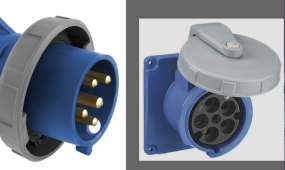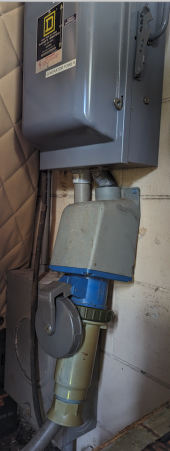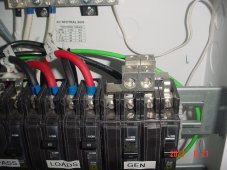Decided to go ahead and provision the option to connect the generator to the
Schneider inverters, so as to be able to charge the Rolls FLA batteries.
Might also use the generator to support loads, under certain conditions, if I can
decipher the XW Pro generator configuration options.
From reading the Schneider documentation, it looks like the load can be simultaneously
supported by the AC2 generator input, batteries and PV.
Need to find an inverter configuration that limits the input on AC2, so that the generator
output (90A) does not fry the XW Pro AC2 relay (60A)
Right now, the Diesel generator is completely separate from the XW Pro inverters.
One or the other can power the house.
A manual transfer switch connects the house to either the inverter output, or the generator.
It is designed this way because the generator can produce almost 90A, and the
Schneider generator input is limited to 60A.
There are occasions when it is helpful to be able to provide 90A to the house, Schneider inverters do not provide that much output.
So the plan is to add another Hubbell HBL5100R9W "pin & sleeve" type,
100A receptacle for the generator output plug.


It will thus be possible to plug the generator in to either the house receptacle,
or the inverter receptacle.
I only expect to have to perform this manual procedure rarely, in exceptional conditions.
A new receptacle connects the generator to the Schneider inverter AC2 inputs,
so I can use the generator to charge the batteries and supplement the Schneider
output during prolonged cloudy days (typically before-during-after hurricanes),
or if Gort obliterates the Sun.

 en.wikipedia.org
en.wikipedia.org
Schneider inverters, so as to be able to charge the Rolls FLA batteries.
Might also use the generator to support loads, under certain conditions, if I can
decipher the XW Pro generator configuration options.
From reading the Schneider documentation, it looks like the load can be simultaneously
supported by the AC2 generator input, batteries and PV.
Need to find an inverter configuration that limits the input on AC2, so that the generator
output (90A) does not fry the XW Pro AC2 relay (60A)
Right now, the Diesel generator is completely separate from the XW Pro inverters.
One or the other can power the house.
A manual transfer switch connects the house to either the inverter output, or the generator.
It is designed this way because the generator can produce almost 90A, and the
Schneider generator input is limited to 60A.
There are occasions when it is helpful to be able to provide 90A to the house, Schneider inverters do not provide that much output.
So the plan is to add another Hubbell HBL5100R9W "pin & sleeve" type,
100A receptacle for the generator output plug.


It will thus be possible to plug the generator in to either the house receptacle,
or the inverter receptacle.
I only expect to have to perform this manual procedure rarely, in exceptional conditions.
A new receptacle connects the generator to the Schneider inverter AC2 inputs,
so I can use the generator to charge the batteries and supplement the Schneider
output during prolonged cloudy days (typically before-during-after hurricanes),
or if Gort obliterates the Sun.



